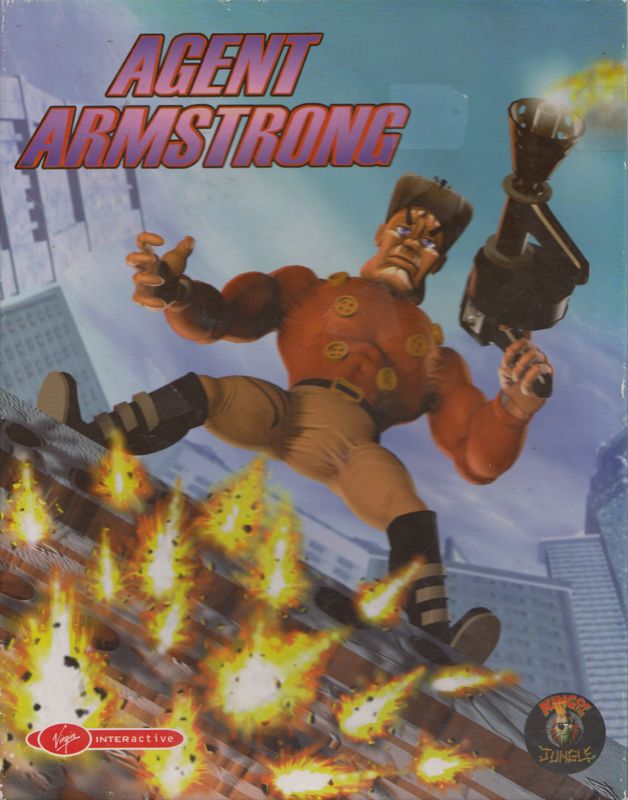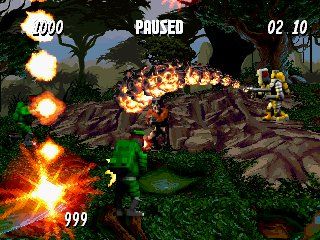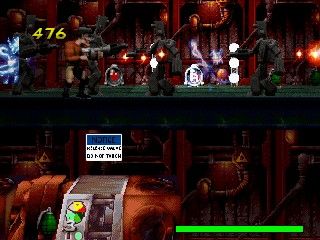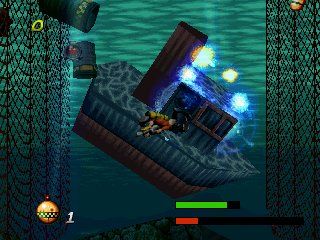Retro Replay Review
Gameplay
Agent Armstrong offers a robust 3D side-scrolling shooter experience that harks back to the early days of the PSX. Each of the 30 mission-based levels presents at least two unique objectives, ensuring that players stay engaged and always have something new to accomplish. Whether you’re destroying Syndicate supply crates, rescuing captured allies, or retrieving stolen artifacts, the variety of tasks keeps the pacing brisk and avoids monotony.
The core combat feels tight and responsive. Armstrong’s arsenal grows steadily as you progress, from a basic pistol to more exotic weapons like rapid-fire submachine guns and depth charges for underwater sections. Ammo management becomes a subtle strategic layer; deciding when to conserve bullets or unleash a hail of fire against waves of enemies adds weight to each encounter.
Boss battles punctuate the experience every five levels or so, shifting from the linear side-scrolling action to more open, free-form arenas. These sequences often require you to dodge sweeping mechanical arms, giant Syndicate tanks or even colossal warships. The learning curve spikes here, but the sense of accomplishment when you topple a boss is undeniably satisfying.
Exploration is encouraged in several stages, especially underwater or jungle environments, where hidden pathways lead to bonus health packs or secret weapon caches. While the primary path shows you the way forward, those willing to backtrack and search are duly rewarded, adding replay value to the campaign.
Graphics
Graphically, Agent Armstrong demonstrates the possibilities and limitations of early PSX hardware. The environments are fully polygonal, ranging from dusty desert outposts to dense tropical jungles and murky underwater caverns. Though character models can appear blocky by modern standards, there’s a certain charm in the texturing and the ambient lighting effects that evoke 1990s console gaming.
Level design often makes clever use of the 3D plane, with foreground and background elements creating a sense of depth during side-scrolling sections. Water physics in underwater stages feel authentically sluggish, complemented by bubble effects and wavering light shafts. These touches highlight the developers’ ambition to push the hardware beyond straightforward left-to-right scrolling.
Cutscenes between chapters employ pre-rendered cinematics that set up the next mission. They’re brief, yes, but they help frame Armstrong’s globe-trotting quest against the Syndicate. Character portraits and stylized title cards maintain consistent aesthetic quality, reinforcing the game’s 1930s pulp-action vibe.
Particle effects—such as explosive debris, muzzle flashes, and shimmering underwater bubbles—are surprisingly well executed for the era. While modern players might long for higher resolutions and smoother frame rates, those willing to embrace retro fidelity will find the visuals both nostalgic and serviceable.
Story
Set in 1930, Agent Armstrong plunges players into a pulp-style showdown with the nefarious Syndicate, a shadowy organization hell-bent on world domination. The narrative unfolds across four continents, each region reflecting different cultural and environmental hazards. From the freezing Russian tundra to the steamy Amazon rainforest, the sense of global scale underpins Armstrong’s mission.
Storytelling is predominantly delivered through mission briefings and interstitial cinematics rather than lengthy dialogue. This keeps the action front and center, though it also means character development is somewhat minimal. Armstrong himself is the archetypal fearless secret agent—daring, resourceful, and perpetually cool under fire.
The Syndicate’s hierarchy is revealed incrementally, with each boss encounter peeling back another layer of the conspiracy. While the villains lack deep backstories, their over-the-top personalities and decorous lairs add theatrical flair to each showdown. It’s pulp fiction at its best—simple, direct, and flamboyant.
Underwater chapters introduce a secondary narrative thread involving lost submarines and hidden Syndicate research labs. These levels feel like gripping side quests that expand the game world. Though the overarching plot remains straightforward, the diversity of settings and mission objectives helps maintain narrative momentum throughout all 30 stages.
Overall Experience
Agent Armstrong stands out as a relic of early PSX ambition, marrying classic side-scrolling shooter mechanics with occasional free-form action sequences. Its 30 varied levels, each with distinct objectives and atmospheric locales, offer roughly a dozen hours of challenging gameplay—an impressive feat for its time.
The balance between linear progression and optional exploration provides both structure and discovery. Boss fights break up the flow in memorable ways, demanding pattern recognition and precision. Though difficulty spikes can be steep, dedicated players will relish the trial-and-error nature of these encounters.
Visually, the game is a snapshot of mid-’90s 3D design: charmingly primitive yet ambitious. Complemented by a rousing soundtrack and period-appropriate sound effects, Agent Armstrong’s presentation reinforces its globe-trotting pulp-adventure identity. Modern gamers seeking hyper-realistic visuals may be disappointed, but retro enthusiasts will appreciate the artistry behind each polygon.
For players looking to experience a piece of PSX history, or those who simply crave a challenging, mission-driven shooter with exotic locales and sizeable boss battles, Agent Armstrong delivers. Its engaging gameplay loops, atmospheric graphics, and straightforward yet spirited storyline combine into a satisfying adventure that remains fun—and occasionally fiendishly tough—even decades after its release.
 Retro Replay Retro Replay gaming reviews, news, emulation, geek stuff and more!
Retro Replay Retro Replay gaming reviews, news, emulation, geek stuff and more!









Reviews
There are no reviews yet.